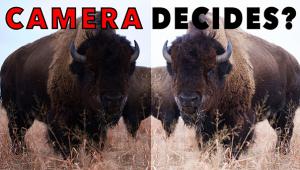Point & Shoot: Wonderful Wildlife Photos
|
One of the most challenging—and gratifying—subjects to photograph is wildlife. The primary obstacle is getting close enough to wild animals to take dramatic photos of them. Your best bet is a telephoto lens—a few point-and-shoot film cameras offer built-in zooms as long as 200mm at the telephoto end, and several digital compact models have zoom lenses as long as 420mm (in a 35mm equivalent). Even inexpensive AF SLRs accept their manufacturers' full line of interchangeable lenses, including long telephotos that are ideal for wildlife photography in the field. Beyond this, it's best to have patience when shooting in an wildlife area. It takes planning, understanding of the animals you want to photograph, and some luck.
The most accessible place to photograph a great variety of animals is at your local zoo. At these facilities, there are basically two ways to approach picture-taking: portraits or other close-up shots of animals, and environmental photos that show the animal and the enclosure that it's confined to. If you choose tight shots, try to fill the frame with the animal or with its head only. Eliminate the background as much as possible, which will distract from the subject. But if you want to make a statement about the zoo, then back up or adjust your camera's lens to a wider setting. Show some of the boundaries of animal enclosures in your pictures, and perhaps how the animals relate to them. Generally, animals are more active in the early morning and late afternoon hours, and sleep during the middle of the day. However, this can differ with various species. Whenever possible, first scout out the animals you want to photograph at the zoo, and then return with your camera when they're likely to be most active. National parks and wildlife refuges are also great locations for wildlife photography. In some of these areas, such as Yellowstone National Park in Wyoming, animals are plentiful and are somewhat accustomed to people. Even at this, you should approach the situation with great caution. Although Bison appear to be calm, low-key animals, in reality they can charge people if they feel threatened. Be especially careful about approaching young, such as bear cubs whose mother may be nearby. Many parks have brochures and books about their wildlife that contain good tips, and park rangers can give you advice on where to find animals at varying times of the year. When taking pictures in wilderness areas, be as unobtrusive as you can. Animals should be unaware or tolerant of your presence. Don't make sudden moves or get too close—watch animals through your viewfinder and be ready to click the shutter at an opportune time. For those lucky enough to go on an African safari, or to the Galapagos Islands, or other areas that are famous for wildlife, take plenty of film or large-capacity memory cards. You'll probably take more pictures than you plan to, and there's nothing worse than having great photo opportunities and running out of film. Digital cameras can be set to varying ISOs, but if you're shooting film, bring some slow, medium, and high-speed film for low light conditions and moving animals. (You might also want to bring an extra camera, because if something goes wrong with your primary one, there's often nowhere to get it fixed in other countries.) Before you go to exotic wildlife areas, read as much as you can about the animals you may encounter. You'll learn more about the behavior that you want to photograph and where you'll find some of these animals. If you're on safari, a guide can transport you to spots with the greatest photo potential. Always keep in mind that an animal is more important than your getting a picture of it. Respect wildlife from a distance—you'll get far more satisfaction out of taking pictures of an animal without disturbing it. Readers are encouraged to submit photos to our monthly Point & Shoot Homework Assignment feature. Please see the table of contents for the location of the entry coupon, which lists topics and more details. |





















































